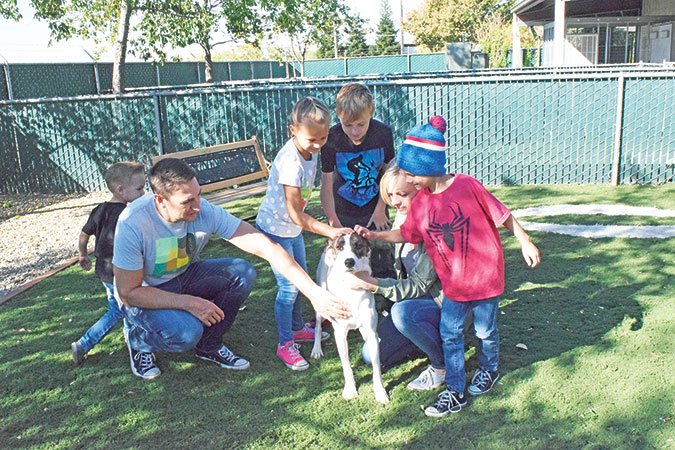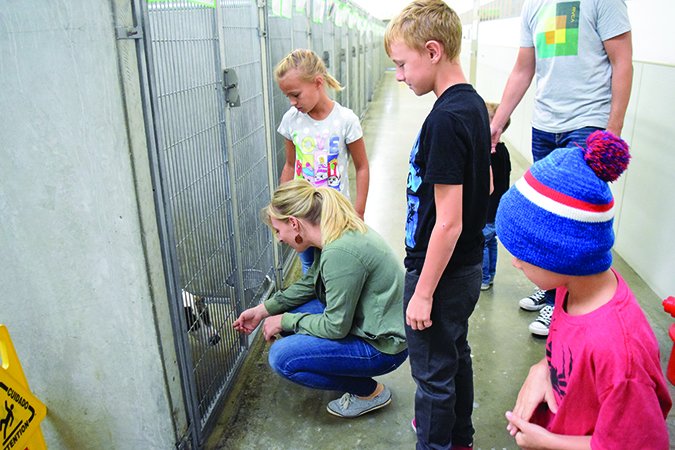So, you’re thinking about adopting a dog. Wonderful! Your whole future with your prospective new dog is ahead of you, and all things are possible. Visions of agility, rally, obedience, trick and/or nosework titles may be dancing in your head, or perhaps long, relaxing walks in a nearby park and snuggles in front of the fireplace on cold winter nights. Maybe you’d like to give back to the community with the warm comfort of a therapy dog. Perhaps you’re looking for a pal for your child.
Whatever your reasons for adopting, with so many dogs looking for their forever humans, how is a dog lover to know which one will be the right match for her family? While it’s not easy to sort through all your adoption options, and there are no guarantees that you will end up with your perfect dog, there are steps you can take to help you make a wise, educated choice and increase the odds that you will find the dog you hope for.
What Kind of Dog Do You Want?
To start, engage the entire family in discussions about what kind of dog you want. If you live alone, have the discussions with yourself. Some things to think about:
Breed
Purebred? Mixed breed? Don’t care? More and more competitions are open to mixed breeds these days, so a desire to compete no longer limits you to purebred dogs. I have owned and loved both pure and mixed breeds. While a purebred dog may be more predictable in terms of size and behavior tendencies, there are no guarantees. I know dog training professionals who have acquired their purebred puppies from reputable breeders and still have had significant behavioral issues. And some of my mixed breeds have been the best dogs ever.
(Note: If you decide to purchase a puppy from a breeder, the process will be very different from that described below. A good breeder will guide you in making your selection. Just be sure to avoid puppies that appear fearful and/or poorly socialized.)
Size
Even if you’re not set on a particular breed, size can matter. I was always a “big dog” person – until we adopted our first Pomeranian. Now I am smitten with small dogs as well as large. Toy-sized dogs may be too fragile for some small children – and can become aggressive in order to protect themselves from unpredictable toddler behavior. Large dogs may be a hazard for small children, especially large active dogs who can easily bowl over a wee human. A bite to a child from a large dog can be far more serious than a bite from a small dog. Small dogs can get underfoot, while large dogs can counter-surf more easily.
Coat
Long-coated dogs are undeniably gorgeous; however, most of those coats require work – some require a lot of work. Do you have time to do a lot of grooming? Do you even want to? A professional groomer is an added pet-care expense you’ll need to figure into your budgeting. Don’t count on the kids promising to do all the brushing; that can be one of those sources of tension, and it’s not fair to the dog to neglect the grooming just because the kids are supposed to do it. Dogs with long and short coats shed.
Color
Do you care about color? Maybe you don’t, but maybe someone else in the family does. Just one more thing to get clear about before venturing out to meet dogs.
Age
Puppy? Adolescent? Adult? Senior? Puppies are perilously cute – and they can be a handful, especially with small children in the home. (I tell clients all the time, “I am a dog training/behavior professional, and I don’t adopt puppies!)
My preferred age is six months to a year – old enough to be past the worst of the puppy stuff, but still young enough to be a relatively clean slate, with many years to look forward to spending together. That said, one of the loveliest dogs I ever adopted was an eight-year-old Rough Collie. Deciding in advance what ages you’ll consider can help prevent an impulse adoption.
Personality
Calm? High-energy? Snuggler? Independent? Bold? Cautious? It helps to have a picture of your ideal temperament in mind.
Health
I respect and admire people who take on dogs who have significant health or behavior problems – but I encourage clients to look for physically and behaviorally healthy dogs.
It’s easy to feel sorry for the hurt and frightened ones – but one should be aware that they can require a massive commitment of time, energy, and financial resources, and still may never be the satisfactory companions you had hoped for. If you do decide to take on a “project dog,” know full well that you may be in for quite a ride. It’s important that your new family member not be the source of tension, so the more agreement you have in advance, the better.

Giving thought to these qualities in advance can, again, help you make an educated choice when you are overwhelmed by all the beseeching eyes in shelter kennels.
Organize Your Dog Criteria List
Now it’s time to organize your thoughts and to get clear about the attributes you hope to find in a new canine family member as well as the traits you would prefer not to have to deal with. Write down your likes and dislikes in columns headed by these categories:
- Must Have
- Would Like to Have
- Would Be Okay With
- Would Prefer Not
- Absolutely Not
Take the list with you when you go to meet your adoption prospects. You don’t necessarily have to rigidly hold yourself to all of them, but if you are tempted by a dog who has few of your family’s “must have” traits, and many of your “would prefer not” traits, at least you will be reminded that you are making a conscious choice to step outside the lines you have drawn. Also, the list may be useful if you need to remind other family members that they agreed to certain criteria (no puppies, no dogs over 50 pounds, etc.).
Best Adoption Sources for Getting a Dog
While you’re thinking about the traits you want in your next dog, start doing your homework about potential sources for your adoptee. Does your local shelter have a good reputation? Are veterinarians seeing a lot of health issues from some of the rescues or shelters in your area? If you look outside your immediate area, you’ll need to be willing to travel. Always meet your potential new family member in person before agreeing to adopt.
Good options for sources of your next dog are:
Reputable Shelters
There are all kinds of shelters, good and bad. Visit the ones in your area. Avoid adopting from shelters that appear overcrowded, dirty, or where staff is unfriendly. Ask if they have adoption counselors to help you with your choice. A good shelter will insist that all family members meet potential canine adoptees and are likely to also insist on meet-and-greets with any current canines in your home.
Reputable Rescue Groups
There are many excellent rescue groups from which you can adopt your canine companion. Ask your local animal control agency and your veterinarian if the group is reputable; both are likely to have had interactions with local rescue staff members and animals from the rescue. It’s also a good idea to consult online sites like guidestar.org and charitycheck101.org to confirm whether an organization is a legitimate 501(c)3 non-profit organization.
Good rescues should be able to provide veterinary and vaccination records for their wards. Ask for references from previous owners or adopters – and call them. Visit housing locations for the dogs. Trust your instincts if you experience red flags, such as an unwillingness to answer questions.
Responsible Breeders
Good breeders will screen you as carefully as you want to screen them. They will have complete health records for all their pups, won’t object to you seeing the puppies’ living area, and meeting the mom – and the dad, too, if he’s on the premises. They will have done lots of foundation socialization work (ask them!). They are likely to have a contract that includes a spay/neuter requirement if the puppy isn’t going to be shown or bred and will commit to taking a dog back anytime during the dog’s lifetime if that becomes necessary.
A breeder who will sell a puppy to anyone who has the purchase price is not a responsible breeder.
Pet Adoption Websites
There are a number of websites that serve as clearinghouses for shelters and rescue groups, listing dogs of various breeds and mixes around the country (and some in Canada). The best known are petfinder.com, adoptapet.com, and rescueme.org.
Friends or family members. Sometimes, sadly, people must give up a dog for a legitimate reason. It can be a significant advantage to all concerned if a dog can be placed in a new home without having to experience the stress of a stay in a shelter or rescue, and if the new owner can communicate directly with the former owner about the dog’s behavior and health history.
Pet Adoption Sources to Avoid at All Costs
Pet Stores
Never, ever. Despite what the store employees may tell you, no responsible breeder sells puppies to pet stores. If you buy a puppy from a pet store, you are without a doubt buying a puppy mill puppy. Don’t. Do. It.
(Note: this is not the same as adopting from a non-profit group that is holding an adoption event at a pet store. That can be acceptable.)
Craigslist
Lots of scammers on craigslist.org. Enough said.
Parking Lots
Hoarders and disreputable rescues are notorious for agreeing to meet you halfway somewhere to “save you the trouble” of a long drive. If you aren’t allowed to see the conditions your potential adoptee is being housed in, chances are it’s not a good situation.
Dog Brokers
Many people are not aware that this is a “thing” – trust me, it is. Dog brokers gather dogs and puppies from shelters, rescue groups, puppy mills, online ads, etc., and sell them for a profit. Given that the dogs are more likely to be well treated, accurately represented, and carefully placed in screened homes (for lower adoption fees) from the first shelter or rescue they found themselves in, it’s unconscionable to pay a broker for them.
Dog brokers often have websites advertising various dogs that they don’t actually have in their possession. When you express interest in a particular dog, they may say, “Oh she just got adopted, but I can find you another (insert breed of your choice) and will get back to you.” Then they scour all their sources to find one, and contact you. Or, they may just meet you with a dog that looks similar and try to pass it off as the dog you saw a photo of.
Non-Reputable Shelters, Rescue Groups, Breeders, Hoarders, etc.
It may be tempting to rescue a dog from a bad situation; just be aware that any support given to these organizations helps perpetuate their efforts.
OK! Got your new dog criteria mapped out and ready to go? See Part 2 of this article for everything you need to do once you get to a shelter. Now get out there and meet some dogs!






Excellent site you’ve got here.. It’s difficult to
find quality writing like yours these days. I honestly appreciate people like you!
Take care!!
fantastic issues altogether, you just gained a new reader.
What would you suggest in regards to your put up that you made a few
days in the past? Any positive?